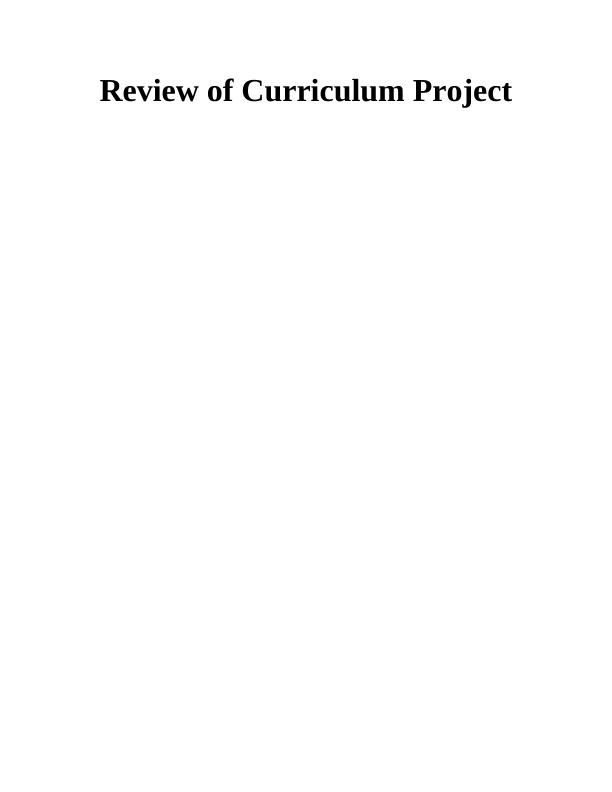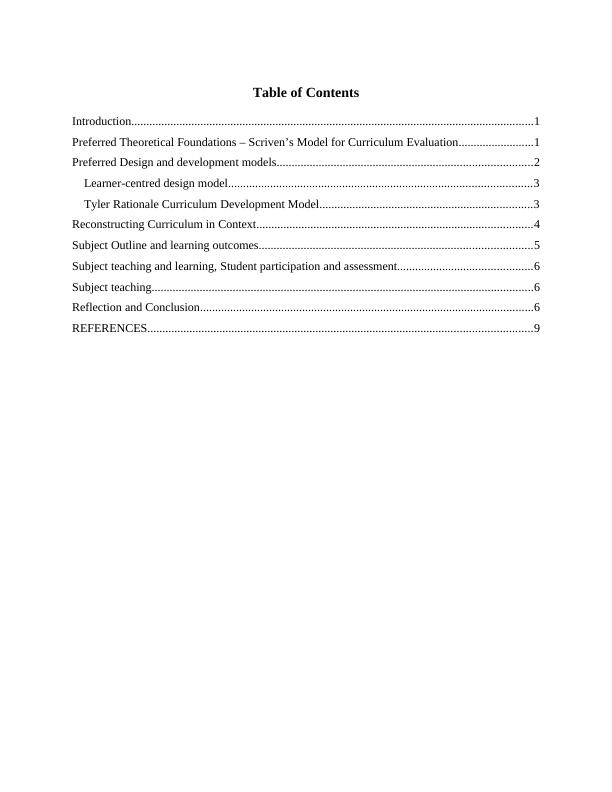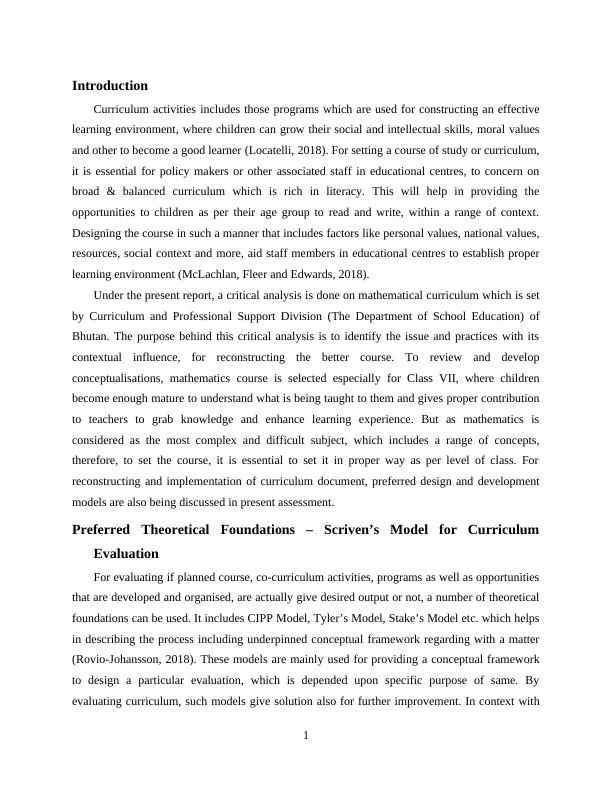Review of Curriculum Project
Added on 2023-01-13
13 Pages3698 Words78 Views
Review of Curriculum Project

Table of Contents
Introduction......................................................................................................................................1
Preferred Theoretical Foundations – Scriven’s Model for Curriculum Evaluation.........................1
Preferred Design and development models.....................................................................................2
Learner-centred design model.....................................................................................................3
Tyler Rationale Curriculum Development Model.......................................................................3
Reconstructing Curriculum in Context............................................................................................4
Subject Outline and learning outcomes...........................................................................................5
Subject teaching and learning, Student participation and assessment.............................................6
Subject teaching...............................................................................................................................6
Reflection and Conclusion...............................................................................................................6
REFERENCES................................................................................................................................9
Introduction......................................................................................................................................1
Preferred Theoretical Foundations – Scriven’s Model for Curriculum Evaluation.........................1
Preferred Design and development models.....................................................................................2
Learner-centred design model.....................................................................................................3
Tyler Rationale Curriculum Development Model.......................................................................3
Reconstructing Curriculum in Context............................................................................................4
Subject Outline and learning outcomes...........................................................................................5
Subject teaching and learning, Student participation and assessment.............................................6
Subject teaching...............................................................................................................................6
Reflection and Conclusion...............................................................................................................6
REFERENCES................................................................................................................................9


Introduction
Curriculum activities includes those programs which are used for constructing an effective
learning environment, where children can grow their social and intellectual skills, moral values
and other to become a good learner (Locatelli, 2018). For setting a course of study or curriculum,
it is essential for policy makers or other associated staff in educational centres, to concern on
broad & balanced curriculum which is rich in literacy. This will help in providing the
opportunities to children as per their age group to read and write, within a range of context.
Designing the course in such a manner that includes factors like personal values, national values,
resources, social context and more, aid staff members in educational centres to establish proper
learning environment (McLachlan, Fleer and Edwards, 2018).
Under the present report, a critical analysis is done on mathematical curriculum which is set
by Curriculum and Professional Support Division (The Department of School Education) of
Bhutan. The purpose behind this critical analysis is to identify the issue and practices with its
contextual influence, for reconstructing the better course. To review and develop
conceptualisations, mathematics course is selected especially for Class VII, where children
become enough mature to understand what is being taught to them and gives proper contribution
to teachers to grab knowledge and enhance learning experience. But as mathematics is
considered as the most complex and difficult subject, which includes a range of concepts,
therefore, to set the course, it is essential to set it in proper way as per level of class. For
reconstructing and implementation of curriculum document, preferred design and development
models are also being discussed in present assessment.
Preferred Theoretical Foundations – Scriven’s Model for Curriculum
Evaluation
For evaluating if planned course, co-curriculum activities, programs as well as opportunities
that are developed and organised, are actually give desired output or not, a number of theoretical
foundations can be used. It includes CIPP Model, Tyler’s Model, Stake’s Model etc. which helps
in describing the process including underpinned conceptual framework regarding with a matter
(Rovio-Johansson, 2018). These models are mainly used for providing a conceptual framework
to design a particular evaluation, which is depended upon specific purpose of same. By
evaluating curriculum, such models give solution also for further improvement. In context with
1
Curriculum activities includes those programs which are used for constructing an effective
learning environment, where children can grow their social and intellectual skills, moral values
and other to become a good learner (Locatelli, 2018). For setting a course of study or curriculum,
it is essential for policy makers or other associated staff in educational centres, to concern on
broad & balanced curriculum which is rich in literacy. This will help in providing the
opportunities to children as per their age group to read and write, within a range of context.
Designing the course in such a manner that includes factors like personal values, national values,
resources, social context and more, aid staff members in educational centres to establish proper
learning environment (McLachlan, Fleer and Edwards, 2018).
Under the present report, a critical analysis is done on mathematical curriculum which is set
by Curriculum and Professional Support Division (The Department of School Education) of
Bhutan. The purpose behind this critical analysis is to identify the issue and practices with its
contextual influence, for reconstructing the better course. To review and develop
conceptualisations, mathematics course is selected especially for Class VII, where children
become enough mature to understand what is being taught to them and gives proper contribution
to teachers to grab knowledge and enhance learning experience. But as mathematics is
considered as the most complex and difficult subject, which includes a range of concepts,
therefore, to set the course, it is essential to set it in proper way as per level of class. For
reconstructing and implementation of curriculum document, preferred design and development
models are also being discussed in present assessment.
Preferred Theoretical Foundations – Scriven’s Model for Curriculum
Evaluation
For evaluating if planned course, co-curriculum activities, programs as well as opportunities
that are developed and organised, are actually give desired output or not, a number of theoretical
foundations can be used. It includes CIPP Model, Tyler’s Model, Stake’s Model etc. which helps
in describing the process including underpinned conceptual framework regarding with a matter
(Rovio-Johansson, 2018). These models are mainly used for providing a conceptual framework
to design a particular evaluation, which is depended upon specific purpose of same. By
evaluating curriculum, such models give solution also for further improvement. In context with
1

End of preview
Want to access all the pages? Upload your documents or become a member.
Related Documents
Reconstructing Curriculum in Mathematicslg...
|11
|3113
|81
Assignment on Curriculum Reconstructionlg...
|29
|7226
|15
Development of Geometry and Measurement for Children Under 12 Years: Learning Shapeslg...
|9
|2342
|452
Philosophical Underpinnings of Curriculum Conceptions and Models of Teaching for Online Learninglg...
|7
|1867
|81
Curriculum Design: Approaches, Purpose, Feedback, Risk Management, and Evaluation Methodologieslg...
|23
|6382
|342
Critical Analysis of Curriculum and Pedagogy in Cambridge International Schoollg...
|8
|2580
|408
